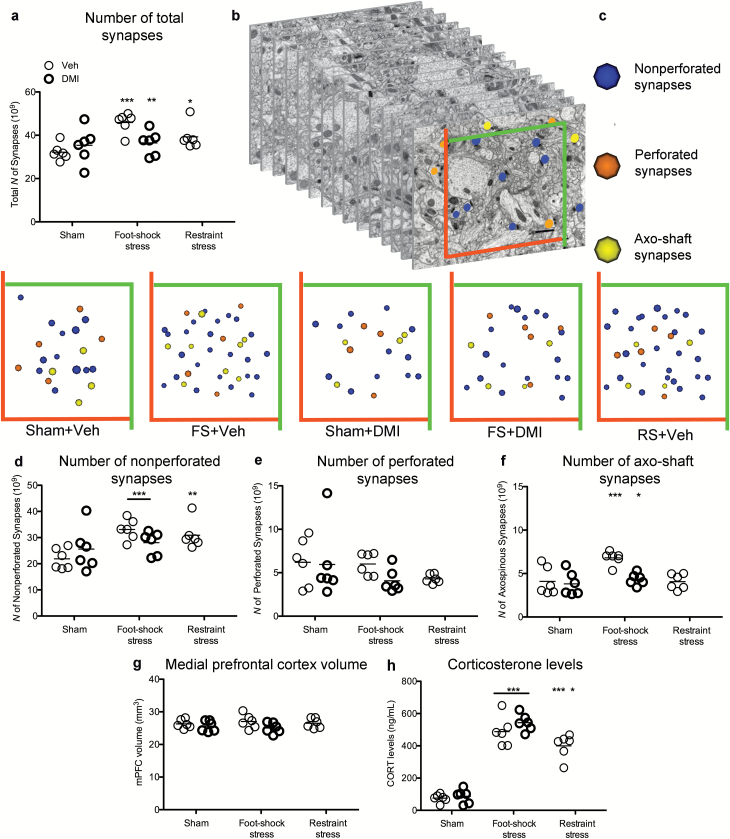Figure 4.
Total number of medial prefrontal cortex (mPFC) excitatory synapses is rapidly and selectively increased after 40 minutes of acute foot shock (FS) stress and after 1 hour of restraint (RS) stress, whereas treatment with chronic desipramine (DMI) partially prevents FS stress-induced synaptogenesis. (a) Total number of mPFC synapses was found to be rapidly increased at the end of 40 minutes of FS stress exposure (P<.001); however, FS stress-induced synaptogenesis was partially prevented by treatment with chronic DMI (P<.01). RS stress also increased the total number of synapses compared with sham vehicle-treated (Veh) group (P<.05). (b) For synapse quantification, a modified physical disector was applied (Tang et al., 2001); a grid was superimposed over 15 serial sections; section 1 was look-up section, sections from 2 to 10 were used as the reference section of the disectors, whereas the last 5 sections were used as look-up sections to ensure that all counted postsynaptic densities were included in the section series. Synaptic profiles touching the inclusion (green) lines were included in the analysis, whereas those touching the exclusion (red) lines were excluded (scale bar=1 μm). Synapses were classified between axo-spinous, synapsing onto spines, including nonperforated (blue dots) and perforated (orange dots). Contacts synapsing directly onto the dendritic shaft were classified as axo-shaft (AXSs) (yellow dots). (c) Application of disector technique allowed unbiased estimates of the number of neocortical synapses, reconstructed here as spheres, within neuropil volume. Blue spheres represent nonperforated synapses (NPSs), orange spheres perforated synapses (PSs), and yellow spheres AXSs. Representative estimates of the number of synapses are reported as the number of 3D spheres for each experimental group: Sham+Veh (n=21); FS+Veh (n=37); Sham+DMI (n=18); FS+DMI (n=26); RS+Veh (n=35). (d) Acute FS stress led to a strong significant increase in small NPSs (P<.001) regardless of DMI treatment. The number of NPSs was also increased in RS animals compared with the sham group (P<.01). (e) The total number of great PSs was shown to be stable among experimental groups. (f) AXSs were found strongly increased after acute FS stress (P<.001), whereas treatment with chronic DMI prevented the stress-induced increase (P<.05). (g) mPFC volume estimated by the Cavalieri estimator did not show any significant difference among experimental groups. (h) Corticosterone concentration was found significantly increased after both FS and RS stress, regardless of previous DMI treatment (P<.001). Compared with RS-stressed animals, rats subjected to FS stress showed higher levels of CORT (P<.05).

